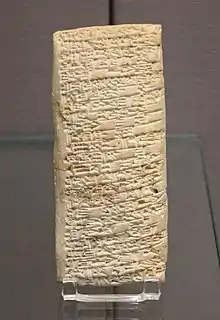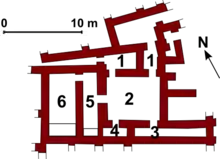Complaint tablet to Ea-nāṣir
The complaint tablet to Ea-nāṣir (UET V 81)[1] is a clay tablet that was sent to ancient Ur, written c. 1750 BCE. It is a complaint to a merchant named Ea-nāṣir from a customer named Nanni. Written in Akkadian cuneiform, it is considered to be the oldest known written complaint. It is currently kept in the British Museum.[2] In 2015, the tablet's content and Ea-nāṣir in particular gained popularity as an internet meme.[3][4][5]

Description
The tablet is 11.6 centimetres (4+9⁄16 in) high, 5 cm (1+15⁄16 in) wide, 2.6 cm (1 in) thick, and slightly damaged.[6]
Content

The tablet details that Ea-nāṣir travelled to Dilmun to buy copper and returned to sell it in Mesopotamia. On one particular occasion, he had agreed to sell copper ingots to Nanni. Nanni sent his servant with the money to complete the transaction.[8] The copper was considered by Nanni to be sub-standard[9] and was not accepted.
In response, Nanni created the cuneiform letter for delivery to Ea-nāṣir. Inscribed on it is a complaint to Ea-nāṣir about a copper delivery of the incorrect grade and issues with another delivery;[6] Nanni also complained that his servant (who handled the transaction) had been treated rudely. He stated that, at the time of writing, he had not accepted the copper, but had paid the money for it.
Acquisition

The tablet was discovered and acquired by Sir Leonard Woolley, leading a joint expedition of the University of Pennsylvania and the British Museum from 1922 to 1934 in the Sumerian city of Ur.[6][10]
Translations
A. Leo Oppenheim translated several of the tablet's lines in a 1954 article for Journal of the American Oriental Society.[11] An English language translation of the tablet was made by W. F. Leemans in 1960;[12] Leemans's translation incorporated these lines which Oppenheim had translated as well as some input from Fritz Rudolf Kraus on the meaning of a few lines.[13] Oppenheim published a full translation of the tablet himself in 1967,[9] unaware of any other translations of this tablet.[14] A translation inspired by that of Marc Van de Mieroop sent in a personal communication to Steven J. Garfinkle was published in 2010;[15] a book review by Walter Farber noted that this translation "is not always true to details".[16] I. M. Diakonoff published a translation into Russian in 1990.[17]
Other tablets
Other tablets have been found in the ruins believed to be Ea-nāṣir's dwelling. These include a letter from a man named Arbituram who complained he had not received his copper yet, while another said he was tired of receiving bad copper.[18][19]
Legacy
The complaint tablet has become an internet meme due to its seemingly anachronistic nature, with Forbes stating that it bore resemblance to many modern customer complaints for poor service in the modern era.[3][18][20]
It has been recognized by the Guinness World Records as the "Oldest Customer Complaint".[21]
References
- Figulla, H.H.; Martin, W.J., eds. (1953). Letters and Business Documents of the Old Babylonian Period. Ur Excavations: Texts. Vol. V. London, UK: British Museum Press. p. 5, Pl. XIV.
- Hyken, Shep (23 April 2015). "Oldest customer service complaint discovered: A lesson from ancient Babylon". Forbes. Retrieved 7 February 2017.
- "The Legend of Ea-Nāsir: how a Babylonian businessman became an internet meme". Institute of Archaeology. 8 December 2022. Retrieved 27 April 2023.
- Kern, Emily (3 November 2021). "The Radical Promise of Human History". Boston Review.
- Brinkley, Liv (17 March 2022). "The World's Oldest Customer Complaint Is Almost 4000 Years Old". Grunge.
- "tablet". British Museum. object W 1953-0411-71.
- "UET 5, 0081 (P414985)". CDLI. Retrieved 23 October 2023.
- Crawford, Harriet (July 2015). "Sir Leonard Woolley and Ur of the Chaldees". The Bible and Interpretation. University of Arizona.
- Oppenheim (1967), pp. 82–83.
- "Sir Leonard Woolley". Biography. British Museum. Collections online.
- Leemans (1960), p. 39 n. 1, citing Oppenheim (1954), pp. 9ff.
- Leemans (1960), pp. 39–40.
- Leemans (1960), p. 39 n. 1.
- Oppenheim (1967), p. 200.
- Garfinkle (2010), p. 198, 198 n. 39.
- Farber (2012), p. 321.
- Diakonoff (1990), p. 116.
- Killgrove, Kristina (11 May 2018). "Meet the worst businessman of the 18th century BCE". Forbes. Retrieved 22 July 2020.
- Leemans (1960), pp. 48–54.
- Podany (2022), pp. 1–2.
- "Complaint Tablet To Ea-Nasir - World's Oldest Complaint Letter". Guinness World Records. Retrieved 5 April 2023.
Further reading
- Baraniuk, Chris (2 March 2015). "Ancient customer-feedback technology lasts millennia". New Scientist. Retrieved 27 April 2023.
- Diakonoff, I. M. (1990). Купец, мореплаватель, литейных дел мастер [A Merchant, Seafarer, and Copper Founder]. Люди города Ура [People of the City of Ur] (in Russian). Moscow: Akademija Nauk. pp. 97–125. ISBN 5-02-016568-9.
- Farber, Walter (2012). "Opening the Tablet Box: Near Eastern Studies in Honor of Benjamin R. Foster". Review of Books. Journal of the American Oriental Society. 132 (2): 319–321. doi:10.7817/jameroriesoci.132.2.0319.
- Garfinkle, Steven J. (2010). "Merchants and State Formation in Early Mesopotamia". In Melville, Sarah; Slotsky, Alice (eds.). Opening the Tablet Box: Near Eastern Studies in Honor of Benjamin R. Foster. Culture and History of the Ancient Near East. Vol. 42. Leiden: Brill. pp. 197–199. doi:10.1163/9789004186569_012. ISBN 978-90-04-18652-1.
- Kruszelnicki, K.S. (24 March 2015). "The oldest known complaint letter". abc.net.au. Australian Broadcasting Corporation. Retrieved 27 April 2023.
- Kalinauskas, Nadine (10 March 2015). "Clay tablet with oldest recorded customer-service complaint on display at the British Museum". Yahoo News. Canada.
- McNally, Victoria (27 February 2015). "Ancient Babylonians were just like us: Complained about poor service from retailers". The Mary Sue.
- Leemans, W.F. (1960). "Ur: Time of Rim-Sin". Foreign trade in the old Babylonian period as revealed by texts from southern Mesopotamia. Studia et Documenta ad Iura Orientis Antiqui Pertinentia. Vol. 6. Leiden, NL: E.J. Brill. pp. 36–55.
- Oppenheim, A. L. (1954). "The Seafaring Merchants of Ur". Journal of the American Oriental Society. 74 (1): 6–17. doi:10.2307/595475. JSTOR 595475.
- Oppenheim, A. Leo, ed. (1967). "Old Babylonian Letters: Trade". Letters From Mesopotamia: Official, Business and Private Letters on Clay Tablets from Two Millennia. The Oriental Institute. Chicago, IL: University of Chicago Press. pp. 82–84.
- Rice, Michael (1994). "The Merchants of Dilmun: Ea-Nasir, the Dilmun Merchant". The Archaeology of the Arabian Gulf. pp. 276–280. doi:10.4324/9780203037263. ISBN 0-415-032687.
- Wheaton, Oliver (5 March 2015). "Believe it or not, this carving is actually a 3,750 year-old customer service complaint". Metro. UK.
- Podany, Amanda H. (2022). "Introduction". Weavers, Scribes, and Kings: A New History of the Ancient Near East. New York: Oxford University Press. pp. 1–10. doi:10.1093/oso/9780190059040.003.0021. ISBN 9780190059040.
- Woolley, Leonard; Mallowan, Max (1976). "Detailed Description of the Private Houses: The AH Site: Old Street". The Old Babylonian Period. Ur Excavations. Vol. VII. London: British Museum Publications. pp. 123–125. ISBN 0-7141-1087-6.
External links
- "UET 5, 0081". Cuneiform Digital Library Initiative. University of California, Los Angeles. CDLI no. P414985. Retrieved 28 September 2022.
- "16814A | 1953,0411.71". UrOnline - The Digital Resource for the Excavation of Ur. The British Museum. Retrieved 28 September 2022.
- "UET 5 81 [BM 131236 = 1953-04-11, 71 = U.16814a]". Archibab. Collège de France. Retrieved 28 September 2022.
- Know Your Meme page